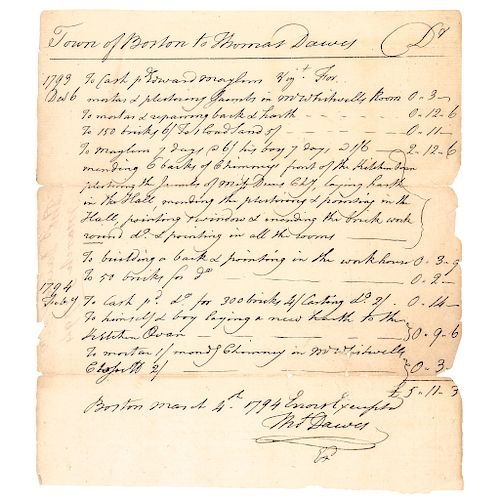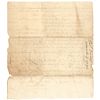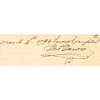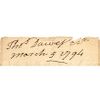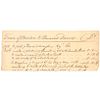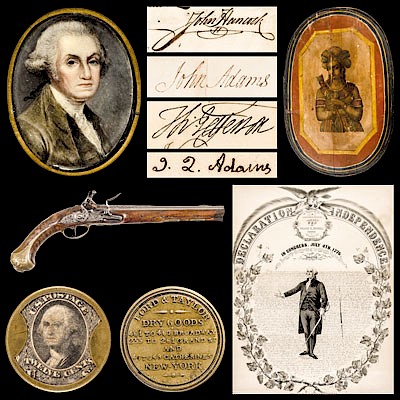1794 Colonel Thomas Dawes Document Signed, Boston, MA Architect-Designer-Builder
Lot 19
About Seller
Early American History Auctions
1520 Commerce St., #312
Winchester, VA 22601
United States
Estimate:
$2,400 - $2,800
Absentee vs Live bid
Two ways to bid:
- Leave a max absentee bid and the platform will bid on your behalf up to your maximum bid during the live auction.
- Bid live during the auction and your bids will be submitted real-time to the auctioneer.
Bid Increments
| Price | Bid Increment |
|---|---|
| $0 | $10 |
| $200 | $20 |
| $300 | $25 |
| $500 | $50 |
| $1,000 | $100 |
| $2,000 | $200 |
| $3,000 | $250 |
| $5,000 | $500 |
| $10,000 | $1,000 |
| $20,000 | $2,000 |
| $30,000 | $2,500 |
| $50,000 | $5,000 |
| $100,000 | $10,000 |
| $200,000 | $20,000 |
| $300,000 | $25,000 |
| $500,000 | $50,000 |
About Auction
By Early American History Auctions
Jun 1, 2019
Set Reminder
2019-06-01 12:00:00
2019-06-01 12:00:00
America/New_York
Bidsquare
Bidsquare : Historic Autographs, Colonial Currency, Political Americana & Revolutionary War Era
https://www.bidsquare.com/auctions/early-american-history-auctions/historic-autographs-colonial-currency-political-americana-revolutionary-war-era-4152
Historic Autographs, Coins, Currency, Political, Americana, Historic Weaponry and Guns, John Adams, Thomas Jefferson, Early American History Auctions auctions@earlyamerican.com
Historic Autographs, Coins, Currency, Political, Americana, Historic Weaponry and Guns, John Adams, Thomas Jefferson, Early American History Auctions auctions@earlyamerican.com
- Lot Description
Autographs
Patriot & Militia Colonel Thomas Dawes - The Cousin of William Dawes, Who Road With Paul Revere On His "Midnight Ride"
COLONEL THOMAS DAWES (1731-1809). Patriot who served as a Massachusetts Militia Colonel during the American Revolution; afterward assumed prominent positions in Massachusetts's government; Architect and Builder designing many notable buildings in Boston, including the Old Street House and the Brattle Street Church.
March 4, 1794-Dated Federal Period, Manuscript Document Signed, "Thos. Dawes" (as Builder/Architect) Town Of Boston, Choice Very Fine. This original Document is headed: "Town of Boston to Thomas Dawes," Boston, 1 page, measuring 8.25" x 7.25" being an invoice for work done by Dawes for Boston. The listed items for various amounts due are given in pounds and shillings. One entry is, "To building a back & pointing in the workhouse." He mentioned repairs done "in Mr. Whitwell's Room," and several repairs, "in the Hall." Docket written upon the blank reverse reads: "Thos Dawes Esqr - March 5, 1794".
Expenses include mortar and brick and the help of another man and his "boy." Others include, "mending 6 backs of Chimneys front of the Kitchen Ovan... laying harth in the Hall... mending the brick work... & pointing in all the rooms" and "laying a new harth to the Kitchen Ovan." Thishistoric Document has fold splits with fine tape reinforcement upon the blank reverse. There are some minor edge chips at the right margin. A wonderful, historical Town of Boston Document made to one of its most important early noted Architect-Designer-Builder, Colonel Thomas Dawes.
A major and highly prominent Boston figure, Dawes received a most Historic Engraved Silver Punch bowl made by Silversmith William Holmes, dated 1763 which is currently displayed within the collection of the Boston Museum of Fine Arts: 10 h x 4 7/8" d x 5 1/4" (base) d x 9 7/8" (lip); wt: 32 oz, 17 1/2 dwt. This magnificent Silver Bowl is engraved with Dawes Family Arms in scroll and foliate cartouche, with drapery below on one side. The Inscription on other side, within engraved and bright-cut medallion with instruments of war and British flags, Reads: "The Gift / of the Field Officers and / Captains of the Regiment / of the Town of BOSTON. to / THOMAS DAWES Esqr / for his past Services as Ad- / jutant to said Re- / giment Sept. 13 / 1763." In addition, there is an important Portrait of Dawes, Painted by Gilbert Stuart, ca. 1806.
Thomas Dawes (August 5, 1731 - January 2, 1809), was a Patriot who served as a Massachusetts militia colonel during the American Revolution and afterward assumed prominent positions in Massachusetts's government. His positions included state councilor, member of the Academy of Arts and Sciences, and representative in both the House and Senate. He ardently supported the Whigs, gaining infamy among Royalists; his house was raided by British Troops during the war. Later, he became active in politics, lived in a roomy house on Purchase Street beside John Adams, and worked as an architect and builder designing many notable buildings in Boston, including the Old Street House and the Brattle Street Church. He attended Old South Church in Deacon from 1786 until his death in 1809, and was a good friend of John Hancock.
Colonel Thomas Dawes
Born: 5 Aug 1731, Boston MA
Marriage: Hannah Blake about 1751 in Boston MA
Died: 7 Jan 1809, Boston MA
Historic Engraved Silver Punch bowl by Silversmith William Holmes, 1763 displayed in the Boston Museum of Fine Arts 10 h x 4 7/8" d x 5 1/4" (base) d x 9 7/8" (lip); wt: 32 oz, 17 1/2 dwt.
Engraved with Dawes arms in scroll and foliate cartouche with drapery below on one side. Inscription on other side, within engraved and bright-cut medallion with instruments of war and British flags: The Gift / of the Field Officers and / Captains of the Regiment / of the Town of BOSTON. to / THOMAS DAWES Esqr / for his past Services as Ad- / jutant to said Re- / giment Sept. 13 / 1763.
Thomas Dawes aunt was William Homes' wife, Rebecca Dawes. Colonel Dawes served as Senator, Moderator, and member of the Governor's Council. He was a builder and worked with the architect Charles Bulfinch. His will, probated on 02 Jan 1809, left ". . . to my Grandson Thomas Dawes Tertius after the decease of his Grandmother Dawes my Gold Watch and Silver Bowl, which was presented to me by the Officers of the Boston Regiment."
Thomas Dawes (August 5, 1731 - January 2, 1809) was a Patriot who served as a Massachusetts militia colonel during the American Revolution and afterward assumed prominent positions in Massachusetts's government. His positions included membership and chairmanship of the Massachusetts Governor's Council, member of the American Academy of Arts and Sciences, and representative in both the House and Senate. As chairman of the Governor's Council, Dawes served briefly as the de jure presiding officer of the executive branch of Massachusetts' state government for ten days - May 20, 1800 to May 30, 1800 - following the death of first Governor Increase Sumner and then Lieutenant Governor Moses Gill. (See List of Governors of Massachusetts.)
Dawes was born in Boston. Prior to the Revolution, he attended a regular school and worked as a mechanic. He ardently supported the Whigs, gaining infamy among Royalists; his house was plundered by the British when they withdrew from Boston in 1776. Later, he became active in politics, lived in a roomy house on Purchase Street beside John Adams, and worked as an architect and builder designing many notable buildings in Boston, including the Old Street House and the Brattle Street Church. He attended Old South Church from 1786 until his death in 1809, and was a good friend of John Hancock.
Dawes, a member of the prominent Dawes family of Massachusetts Bay, was a cousin of the April 1775 Whig patriot William Dawes.
- Shipping Info
-
Early American provides in-house worldwide shipping. Please contact us directly if you have questions about your specific shipping requirements.
-
- Buyer's Premium



 EUR
EUR CAD
CAD AUD
AUD GBP
GBP MXN
MXN HKD
HKD CNY
CNY MYR
MYR SEK
SEK SGD
SGD CHF
CHF THB
THB